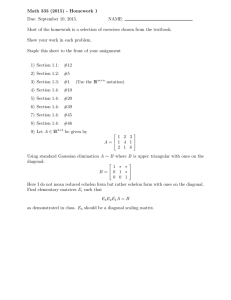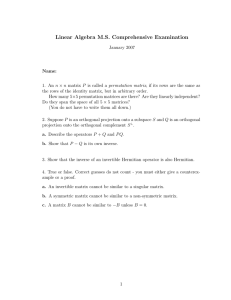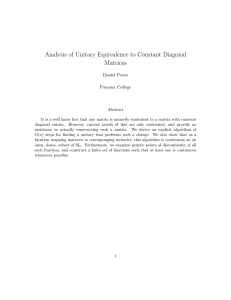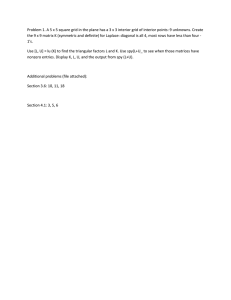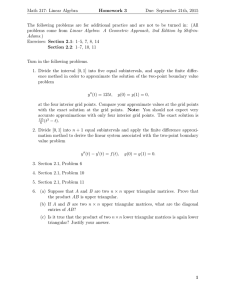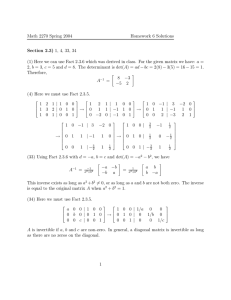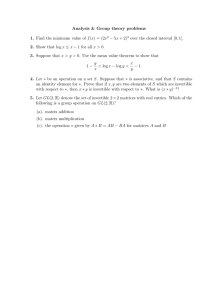The main diagonal of a permutation matrix Please share
advertisement
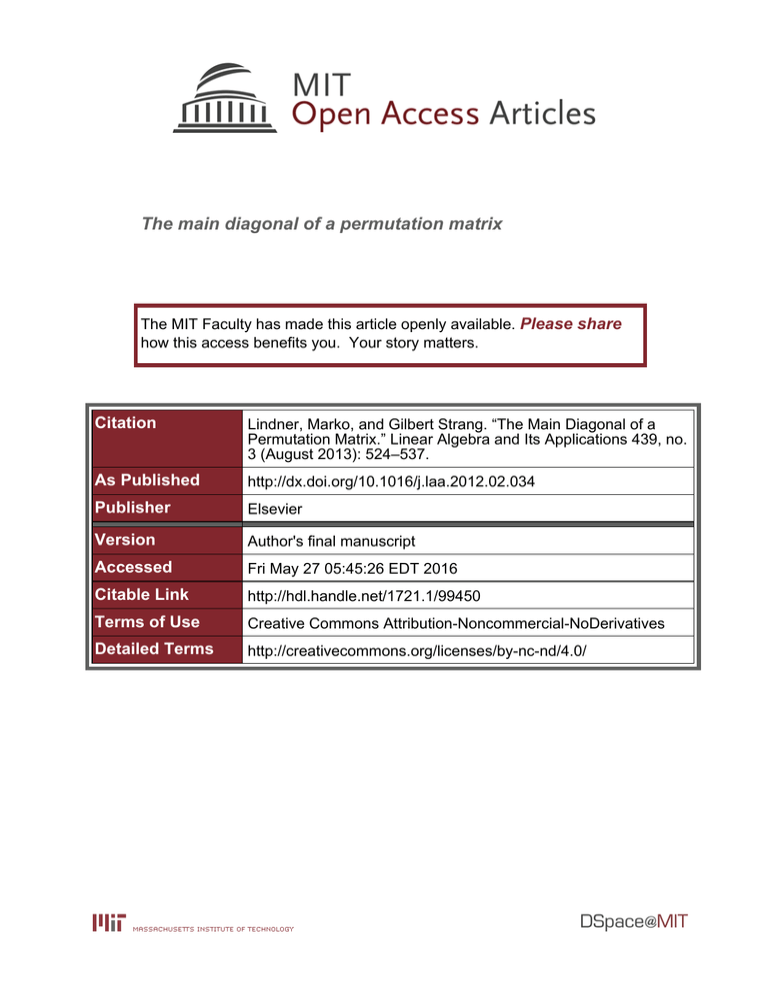
The main diagonal of a permutation matrix
The MIT Faculty has made this article openly available. Please share
how this access benefits you. Your story matters.
Citation
Lindner, Marko, and Gilbert Strang. “The Main Diagonal of a
Permutation Matrix.” Linear Algebra and Its Applications 439, no.
3 (August 2013): 524–537.
As Published
http://dx.doi.org/10.1016/j.laa.2012.02.034
Publisher
Elsevier
Version
Author's final manuscript
Accessed
Fri May 27 05:45:26 EDT 2016
Citable Link
http://hdl.handle.net/1721.1/99450
Terms of Use
Creative Commons Attribution-Noncommercial-NoDerivatives
Detailed Terms
http://creativecommons.org/licenses/by-nc-nd/4.0/
arXiv:1112.0582v2 [math.NA] 15 Dec 2011
The Main Diagonal of a Permutation Matrix
Marko Lindner and Gilbert Strang
Abstract
By counting 1’s in the “right half” of 2w consecutive rows, we locate the main diagonal of any doubly infinite
permutation matrix with bandwidth w. Then the matrix can be correctly centered and factored into blockdiagonal permutation matrices.
Part II of the paper discusses the same questions for the much larger class of band-dominated matrices. The
main diagonal is determined by the Fredholm index of a singly infinite submatrix. Thus the main diagonal is
determined “at infinity” in general, but from only 2w rows for banded permutations.
Mathematics subject classification (2010): 15A23; 47A53, 47B36.
Keywords and phrases: banded matrix, permutation, infinite matrix, main diagonal, factorization.
1
Introduction
This paper is about banded doubly infinite permutation matrices. These matrices represent
permutations of the integers Z, in which no integer moves more than w places. The banded
matrix P has zero entries pij whenever |i − j| > w, and it has exactly one entry pij = 1 in each
row and column. So P has 2w + 1 diagonals that are possibly nonzero, and exactly one of these
deserves to be called the main diagonal. The first objective of this paper is to find the main
diagonal of P .
The remarkable fact is that the correct position of the main diagonal is determined by any 2w
consecutive rows of P . This will be Theorem 1. Normally that position can only be determined
“at infinity”.
For a much larger class of biinfinite matrices A, we form the singly infinite submatrix A+
from rows i > 0 and columns j > 0 of A. The plus-index of A is the usual Fredholm index of
A+ , computed from the dimension of its nullspace and the codimension of its range:
index+ (A) = index(A+ ) = dim N(A+ ) − codim R(A+ ).
(1)
For any Fredholm operator, including all permutations A = P , those two numbers are finite.
Then the main diagonal of A is determined by κ = index+ (A). It is found κ diagonals above
(or −κ diagonals below) the zeroth diagonal of A. So our problem is to compute that index.
Example 1.1 The doubly infinite forward shift S has nonzero entries Si,i−1 = 1 for i ∈ Z. Its
singly infinite submatrix S+ is lower triangular, with those ones along the first subdiagonal. The
1
nullspace of S+ has dimension = 0 (independent columns of S+ ) but the range has codimension
= 1 (it consists of all singly infinite vectors with a zero in the first position). Thus κ =
index+ (S) = 0 − 1 and the main diagonal of S is correctly located: It is one diagonal below the
zeroth diagonal of S (and it contains the ones).
Since S is a permutation of Z with bandwidth w = 1, Theorem 1 says that index+ (S) can be
found from any two consecutive rows i and i+1 of S: “Count the ones in columns i+1, i+2, . . .
and subtract w.” The result 0 − 1 agrees with index+ (S).
We can directly state Theorems 1–3, for banded permutations P of Z. Two proofs are given
for Theorem 1. Then Part II of the paper discusses the much larger class of doubly infinite
band-dominated Fredholm operators A. The plus-index of A (and thus its main diagonal) is
well defined but not so easily computable.
Theorem 1 If P has bandwidth w, its plus-index is determined by rows 1, . . . , 2w and columns
j > w. Subtract w from the number n of ones in this submatrix. The result κ = n − w is the
plus-index of P , and the main diagonal of P is κ diagonals above the zeroth diagonal.
The same result κ comes from rows j ∗ − w to j ∗ + w − 1 and columns ≥ j ∗ , for any j ∗ ∈ Z.
The submatrix is shown in (13) below.
Equivalently, Pc = S κ P is a centered permutation of Z, by which we mean that its zeroth
diagonal is the main diagonal. Our first proof will show how the submatrix with 2w rows was
discovered. The second proof goes directly to the index κ.
Theorem 2 Every centered permutation Pc of Z
product of two block-diagonal permutations:
·
B0
Pc = BC =
B1
..
.
with bandwidth w can be factored into a
..
.
C0
C1
·
(2)
All blocks have size 2w and each Ci is “offset” between Bi and Bi+1 (shifted by w rows and
columns, as shown).
Theorem 3 The centered permutation Pc can be further factored into N < 2w block-diagonal
permutations of bandwidth 1:
Pc = F1 F2 · · · FN
(3)
Each factor Fi has block size 1 or 2. Thus Fi exchanges disjoint pairs of neighboring rows.
By Theorems 1–3 the original P is factored into
P = S −κ Pc = S −κ BC = S −κ F1 F2 · · · FN .
2
2
The index and the plus-index
We say that an infinite matrix A = (aij )i,j∈Z is invertible if the linear operator that it represents
via matrix-vector multiplication is invertible as an operator from ℓ2 (Z) to ℓ2 (Z). A bounded
linear operator A from ℓ2 into ℓ2 is invertible iff it is both injective (its nullspace N(A) = {x ∈
ℓ2 : Ax = 0} consists of 0 only) and surjective (its range R(A) = {Ax : x ∈ ℓ2 } is all of ℓ2 ).
Deviation from both properties is measured in terms of the two integers
α = dim N(A)
and
β = codim R(A).
(4)
A is a Fredholm operator if both α and β are finite. Then the Fredholm index (or just the
index) of A is the difference
index(A) = α − β.
(5)
Unlike the separate numbers α and β, their difference α − β has these important properties:
• the index is invariant under compact perturbations A + K;
• the index of a product obeys the remarkable formula index(AB) = index(A) + index(B);
• the index is continuous with respect to the operator norm of A (and therefore locally
constant); and
• all finite square matrices have index zero.
All Fredholm matrices of index zero, including all finite square matrices, obey the Fredholm
alternative: Either A is injective and surjective (α = 0, β = 0) or A is not injective and not
surjective (α 6= 0, β 6= 0). This is the set of all operators A = C + K with C invertible and
K compact. See e.g. [7, 10] for a nice introduction to Fredholm operators. The property of
being invertible on ℓp (Z) and the index itself are independent of p ∈ [1, ∞] for a certain class
of infinite matrices (with uniformly bounded entries and summable off-diagonal decay), see
[12, 14].
Our interest in the index (more precisely, the plus-index) of a biinfinite matrix originates
from the following natural question:
Which diagonal is the main diagonal of a biinfinite matrix?
For a symmetric matrix, the zeroth diagonal is the main diagonal. For a Toeplitz matrix (a
polynomial in the shift S), a zero winding number is the key. A wider class of structured
matrices was analyzed by de Boor [8]. For Fredholm operators in general, Israel Gohberg’s
diplomatic answer to this question was that every diagonal has the right to be the main diagonal
[3, p. 24]. But there are concrete problems waiting for a concrete answer. Here are two such
problems:
1. For finite and semiinfinite matrices, the inverse of a lower triangular matrix is again lower
triangular. This may fail if A is biinfinite (essentially because the ‘wrong’ diagonal is
3
mistaken for the main diagonal). The inverse of the lower triangular shift S is the upper
triangular backward shift S ⊤ . Shifting S one row up (treating the ones as the main
diagonal) resolves this conflict.
Here is a slightly more sophisticated example: A = S − 21 S 2 is lower triangular with its
inverse neither lower nor upper triangular. Shift up by one row: B = S −1 A = I − 12 S
is lower triangular with B −1 = I + 12 S + 41 S 2 + · · · also lower triangular (as we want).
Shift up one more row: C = S −2 A = S −1 − 12 I is now upper triangular with C −1 = B −1 S
lower triangular. In this example the diagonal consisting of all ones should be the main
diagonal, and B is centered (even though triangular) so that its inverse is triangular of
the same kind.
2. The numerical solution of biinfinite systems Ax = b can approximate A−1 by the inverses
of finite square submatrices (finite sections) of A. Their upper left and lower right corners
lie on the main diagonal of A. But again, which diagonal should that be? For A =
2S 2 + 21 S − I + 2S −1 , one can show [4, 5] that it has to be the diagonal that carries all
the 21 ’s. Finite sections that are centered along one of the other nonzero diagonals are
invertible (for sufficiently large sizes) but their inverses do not converge (they blow up).
Problem 1 and 2 are not unrelated: If A is lower triangular and the inverses of its finite sections
(which are also lower triangular) approximate A−1 , then A−1 will be lower triangular, too.
A similar argument can be used to transfer Asplund’s theorem [2, 25] to infinite matrices,
explaining the relations between ranks of submatrices of A and A−1 . We demonstrate this in
Part II of this paper.
The answer to both problems is the same: Shift A down by κ rows, or equivalently by κ
diagonals, where κ is the plus-index of A [17]:
a11 a12 · · ·
(6)
κ = index+ (A) = index(A+ )
and
A+ = a21 a22 · · ·
..
.. . .
.
.
.
A+ is a semiinfinite submatrix of A. This shifting process is called index cancellation [9, 11].
The centered matrix Ac = S κ A has index+ (Ac ) = 0 (see (16) below). This is necessary for
a triangular matrix to have a triangular inverse of the same kind (Corollary 6.4). It is also
necessary for the convergence of the inverses of the finite sections to A−1 (see [15, 20]).
How is this plus-index κ computed? In [17] it is shown that κ is invariant under passing
to a “limit operator” [18, 13, 6] of A at +∞, which often simplifies the computation. For the
plus-index of a permutation P , the limit operator is not needed and the new formula (12) is as
simple as possible.
4
Part I
Permutation matrices
3
The plus-index of a biinfinite permutation matrix
Now we come to the problem of computing the plus-index of a biinfinite permutation matrix.
So let π : Z → Z be a permutation (a bijection) of the integers and put P = (pij )i,j∈Z with
1 if j = π(i),
pij = δπ(i),j =
0 if j 6= π(i).
The matrix P is banded iff the maximal displacement w of any integer via π is finite:
w := sup |i − π(i)| is the bandwidth of P .
(7)
i∈Z
Every permutation matrix P is invertible. So the submatrix P+ is always Fredholm (see
Lemma 5.2 below) and it makes sense to ask for its index: the plus-index of P .
It seems a bit arbitrary to define the plus-index of a biinfinite matrix A based on the
submatrix A+ that starts at the particular entry a11 . Lemma 3.1 shows that for banded
permutations, the submatrix Ak starting at akk gives the same plus-index for every k ∈ Z:
ak,k
ak,k+1 · · ·
a
ak+1,k+1 · · ·
Ak := (aij )∞
(8)
i,j=k = k+1,k
..
..
..
.
.
.
Lemma 3.1 If P is a banded biinfinite permutation matrix and k ∈ Z then index+ (P ) =
index(Pk ) holds independently of k.
Proof. Let k ∈ N first. Because the first k rows and columns of P0 contain only finitely many
nonzero entries, we have the following equality modulo finite rank operators:
0
0
0
I
k×k
k×k
∼
P0 ∼
(9)
=
=
0
Pk
0 Pk
Consequently, index(P0 ) = index(Pk ). For k ∈ Z \ N the argument is very similar.
We will write P+ for any of these singly infinite submatrices Pk . Notice that P+ can be
the zero matrix (not Fredholm) when P is not banded. An example is the permutation that
exchanges every pair i and −i, for i ∈ Z.
Here is a concrete formula for the plus-index of permutation matrices that “split”:
5
Theorem 3.2 Let π be a permutation of the integers (not necessarily banded) and denote the
corresponding matrix by P . Suppose there exist i∗ and j ∗ such that
{π(i) : i < i∗ } = {j : j < j ∗ }.
(10)
Then index+ (P ) = j ∗ − i∗ .
Proof. If such integers i∗ and j ∗ exist then P decouples into two blocks:
.
..
..
.
(1)
P
0
· · · pi∗ −1,j ∗ −1
P =
=:
pi∗ ,j ∗ · · ·
0 P (2)
..
..
.
.
(11)
The meeting point (i∗ , j ∗ ) may not fall on the zeroth diagonal of P (in fact, it falls on the main
diagonal). Because P is invertible, P (1) and P (2) are invertible. It is now easy to show that
j ∗ − i∗ is the plus-index of P :
Case 1. If i∗ ≤ j ∗ then, putting k := i∗ , we have that Pk starts with j ∗ − i∗ zero columns.
Those are followed by P (2) , so that the index of Pk is (j ∗ − i∗ ) − 0 = j ∗ − i∗ .
Case 2. If i∗ > j ∗ then, putting k := j ∗ , we have that Pk has i∗ − j ∗ zero rows, followed by
P . Again the index is 0 − (i∗ − j ∗ ) = j ∗ − i∗ .
(2)
It remains to apply Lemma 3.1.
Adding κ = j ∗ − i∗ to all row numbers moves the meeting point of the blocks in (11) to
position (j ∗ , j ∗ ). In fact index+ (A) = j ∗ − i∗ holds for all invertible matrices A (not just
permutations) that decouple in the sense of (11).
The first question is whether or not such a splitting will appear in every permutation of Z
– and the unfortunate answer is no!
Example 3.3 (symmetric and intertwined) Let us depict this permutation by a graph
with vertex set Z and with a directed edge (an arrow) from i to j iff j = π(i).
This permutation is symmetric (π(i) = j iff π(j) = i). In such a case, splitting happens iff the
graph falls into separate components {i < i∗ } and {i ≥ i∗ }. Then the graph can be split in two
without cutting any edge, which is obviously impossible in our example.
Of course, this symmetric sitation means that P = P ⊤ and hence P+ = (P+ )⊤ so that
index(P+ ) must be zero – and we don’t need help from Theorem 3.2. But here is a nonsymmetric version of essentially the same example:
6
Example 3.4 (previous example, shifted) π ′ (i) := π(i) + 1.
Without symmetry it is not so easy to see that splitting is impossible. In fact, this graph is
disconnected (it has three components) but it cannot be split.
There is a simple trick to make splitting immediately visible in every permutation’s graph.
We will demonstrate this trick for a simpler example 3.5.
Example 3.5 Let π(i) := i + 1. The corresponding matrix is our shift, S.
The graph is clearly connected but we have a split at every single position i∗ , with j ∗ = i∗ + 1
in (10). This is more easily seen by depicting the i’s and the j’s separately, where we draw an
arrow from i to j if j = π(i):
In general, splitting (10) is equivalent to a separation like this:
The nodes {i < i∗ } are only connected to {j < j ∗ } and the nodes {i ≥ i∗ } only to {j ≥ j ∗ }. By
shifting the i-axis accordingly, one can straighten the cut to perfectly vertical. This is exactly
what index cancellation does. Shifting the i-axis corresponds to renumbering the rows of our
matrix. The plus index j ∗ − i∗ is obvious if one thinks in terms of these i-j-graphs rather than
the matrix. The conclusion that there is no split in Example 3.4 is now a simple exercise.
7
How do we compute the plus-index when the graph does not split? Here is our agenda:
• By changing finitely many arrows, we construct a new permutation π ′ that does split.
• This is possible with the split at any given position j ∗ .
• Changing finitely many arrows only changes finitely many matrix entries. Therefore π
and π ′ have the same plus-index, and we know that the index for π ′ is j ∗ − i∗ .
Step 1: Delete arrows. Choose an arbitrary position j ∗ ∈ Z where the split should cross
the j-axis. First delete the 2w arrows i 7→ π(i) with i = j ∗ − w, ..., j ∗ + w − 1 from the graph
of π. Then the remaining diagram will have a big gap:
The endpoints of the 2w deleted arrows are now empty. Put those endpoints (the column
numbers) into ascending order. Suppose n of those column numbers are greater than or equal
to j ∗ – their endpoints are to the right of the split. The other 2w − n endpoints are to the left.
Step 2: Rewire.
Insert 2w new arrows connecting the empty starting points i =
j ∗ − w, ..., j ∗ + w − 1 to the (ordered!) empty endpoints.
The new permutation π ′ splits at i∗ = j ∗ + w − n. If P ′ is the matrix for π ′ , then P+′ − P+ is
of finite rank. Therefore P+ and P+′ have the same index. This index comes directly from the
splitting point of π ′ :
κ = index+ (P ) = index(P+ ) = index(P+′ ) = j ∗ − i∗ = n − w.
(12)
Remark 3.6 We are just reordering the 1’s in 2w consecutive rows of P . In the new order,
those 1’s go from left to right. The figure has w = 3 and there are n = 4 ones on the right.
Then in this example the index is κ = 4 − 3 = 1.
8
The number of 1’s in columns j ≥ j ∗ is n. Thus we are counting the 1’s in the following
submatrix R, and subtracting the bandwidth w to obtain the index κ = n − w:
0
pj ∗ −w,j ∗ · · ·
..
..
..
R=
(13)
.
.
.
pj ∗ +w−1,j ∗ · · · pj ∗ +w−1,j ∗ +2w−1
This submatrix R is lower triangular because P has bandwidth w. This completes our first
proof of Theorem 1.
To some extent this result is surprising. The Fredholm index is robust under perturbations
in finitely many matrix entries – so it must be encoded somewhere deep down at infinity. (This
is exactly where the limit operator approach [18, 13, 6], that we mentioned before, enters the
stage.) But for banded permutation matrices, the plus-index can be computed from a finite
submatrix – independent of the position. This is clearly a consequence of the ‘stiff’ rules
(exactly one 1 in each row and column – and never leave the band!) that these matrices have
to follow.
Second proof of Theorem 1. The first proof identified the “right half” of any 2w consecutive rows of P , as sufficient to determine the index of P+ . Now we can give a direct proof by
counting the 1’s in that right half R. In the figure below, the infinite submatrix P+ is marked
out by double lines, starting on the zeroth diagonal (marked with ×’s). We divide R into a
part R1 outside P+ and a part R2 inside P+ . Now count the 1’s in each part :
w rows
w rows
•
•
•
×
•
•
•
•
•
×
•
R1
•
• •
• • •
R2
× • • •
Each 1 in R1 will mean a zero column below it in P+ . The other columns of P+ are complete:
dimension of nullspace of P+ = number of 1’s in R1 .
Any zero rows in P+ will be zero rows in R2 . Those are counted by the 1’s that are missing
from the w rows of R2 :
codimension of range of P+ = w − (number of 1’s in R2 ).
Subtraction gives the index formula in Theorem 1:
index of P+ = (number of 1’s in R) − w = n − w.
4
(14)
Factorizations of banded permutations
This short section establishes the factorizations Pc = BC and Pc = F1 F2 · · · FN of centered
permutation matrices Pc (plus-index equal to 0). The block-diagonal permutations B, C have
block size 2w and F1 , · · · , FN have block size 1 or 2.
9
Both factorizations are particularly simple cases of a more general theorem [22, 23] for
banded matrices with banded inverses. For permutations, P and P −1 = P ⊤ have the same
bandwidth w. Figure 4.1 below shows a typical matrix Pc with w = 2. Each non-empty square
of size 2w = 4 contains two 1’s (by Theorem 1), because Pc is centered (κ = 0).
Step 1. There is a 1 in each row and column. Row exchanges from the block B1−1 will
move the 1’s in the first square into the top two rows (and thus 1’s go into the last two rows of
the second square). The block B2−1 acts in the same way on the next four rows of Pc . All the
circled entries • have become zero.
Step 2. C1−1 executes column exchanges to move the 2 + 2 = 4 ones in its columns to the
main diagonal (marked by ×). When all blocks Bi−1 and Ci−1 act in this way, we reach the
identity B −1 Pc C −1 = I and hence Pc = BC. This is Theorem 2.
multiply by B1−1
multiply by B2−1
C0−1
C1−1
• • × • •
• • × • •
• • × • •
• • × •
• • ×
• •
•
C2−1
•
•
×
•
•
•
• •
× • •
• × • •
Figure 4.1: Each square has rank 2. B1−1 and B2−1 produce zeros in the circled positions by row exchanges.
Then C1−1 produces (by column exchanges) the 4 by 4 identity matrix with ones in the diagonal positions ×.
A similar factorization was established in [21] for any banded matrix with banded inverse.
The same result was found for unitary banded matrices in [17], with a different proof. It appears
that 2w is the right block size for these block-diagonal factorizations A = BC.
Theorem 3 says that it is possible to factor Pc into even simpler block-diagonal permutations
F1 F2 · · · FN . Now the blocks of each factor are 2 × 2 or 1 × 1. Thus each Fi exchanges a set
of disjoint pairs of neighbors (as in the bubblesort algorithm, but with disjoint exchanges in
parallel for much greater efficiency).
A beautiful proof that N < 2w was given by Greta Panova [16, 1, 23]. We won’t repeat the
details. Her key idea is a variation on the “wiring diagram” of a permutation.
Briefly, that diagram connects each point (0, i) for i ∈ Z by a straight line to the point
(1, πc (i)). The intersections of those lines tell us the order in which to exchange neighbors. Key
point: All intersections lie on N < 2w vertical lines in the [16, 23]. Exchanges on each vertical
line can be executed in parallel by a matrix Fi (its bandwidth is 1). Then Pc is the product
F1 F2 · · · FN with N < 2w.
10
Part II
Band-dominated matrices
5
The plus-index of a band-dominated matrix
A is a band matrix if it is supported on finitely many diagonals only, and it is a band-dominated
matrix if it is the limit (in the ℓ2 → ℓ2 operator norm) of a sequence of band matrices.
Ak is the semiinfinite submatrix (8) consisting of rows i ≥ k and columns j ≥ k. Then
Lemma 3.1 generalizes from permutation matrices to band-dominated matrices that are Fredholm:
Lemma 5.1 If A is band-dominated and Fredholm then the index of Ak is independent of
k ∈ Z.
Proof. If A is a band matrix then the proof is literally that of Lemma 3.1 above. If A is
band-dominated (i.e. in the closure of the set of band matrices) then the identification (9) still
holds modulo compact operators, which is enough to prove the claim.
In analogy to A+ = A1 we introduce the semiinfinite matrix A− that ends at a0,0 :
..
..
..
.
.
.
A− := (aij )0i,j=−∞ = · · · a−1,−1 a−1,0
· · · a0,−1 a0,0
Then A− and A+ will together determine the index of A:
A− A−+
0
A
−
∼
A =
=
A+− A+
0 A+
(15)
modulo compact operators since A−+ and A+− are compact. (Those off-diagonal blocks have
finite rank if A is a band matrix and they are norm limits of finite rank matrices, hence compact,
if A is band-dominated.) From this identification (15) we immediately have Lemma 5.2:
Lemma 5.2 [17] A band-dominated biinfinite matrix A is Fredholm iff both A+ and A− are
Fredholm. In that case
index(A) = index(A+ ) + index(A− ).
So if A is invertible then index(A+ ) = −index(A− ). Clearly, all results that we prove for the
plus-index have their counterpart for the minus-index, index− (A) = index(A− ). Here is another
important result on the plus-index:
Lemma 5.3 If A and B are band-dominated and Fredholm biinfinite matrices then
index+ (AB) = index+ (A) + index+ (B).
11
Proof. By (15) we have, modulo compact operators,
B− 0
A− B−
0
A− 0
∼
=
,
AB =
0 A+
0 B+
0
A+ B+
so that (AB)+ ∼
= A+ B+ , whence index((AB)+ ) = index(A+ B+ ) = index(A+ ) + index(B+ ).
Recalling the forward shift S with index+ (S) = 0 − 1 = −1, Lemma 5.3 yields
index+ (S κ A) = κ · index+ (S) + index+ (A) = −κ + index+ (A).
(16)
Then if κ = index+ (A), index cancellation Ac := S κ A indeed leads to plus-index zero.
6
Triangular matrices
The plus-index of a general band-dominated matrix A is not easy to compute. We will assume
that A is banded and invertible (as a bounded operator on ℓ2 (Z)). One possible approach (far
from complete in this paper) is to factor A into a lower triangular L and an upper triangular
U, with a banded permutation P in between:
A = LP U = (lower triangular)(permutation)(upper triangular).
This extends the factorization that comes from Gaussian elimination on a finite invertible
matrix. Notice the “Bruhat convention” that places P between L and U. In that position P
is unique. When P is a finite matrix, the 1’s are all determined by the ranks of the upper
left submatrices of A. Elimination proceeds as normal (subtracting multiples of the pivot rows
from lower rows) except that we wait to the end to reorder the pivot rows into U by using P .
The steps are described in [24], where the main purpose is to extend A = LP U to biinfinite
matrices A (banded and invertible). The factors L, P, U have bandwidth ≤ 2w. But the
elimination process has to be reconsidered, since it can no longer start at a11 (which is not the
first entry, it is in the center of the matrix). Briefly, we look at the upper left submatrices
Ak− (singly infinite) containing columns ≤ k and rows ≤ k + w. By Fredholm theory, the
index of Ak− is independent of k. Its columns are independent because A is invertible (and all
nonzeros survive into Ak− ). Any dependent rows of Ak− are among the last 2w rows (for the
same reason). So the minus-index of A and the location of its main diagonal are determined
by the number d of dependent rows.
Since d does not depend on k, one row changes to independent and a new dependent row
appears (if d > 0) when k increases to k +1. That newly independent row is the pivot row in the
following elimination step. Dependence involves all the earlier rows of Ak− , so this elimination
process is not constructive—at least not in the usual sense.
Note: We say that an infinite set of vectors {v
Pi }i∈I with I ⊂ Z is linearly dependent if there
2
is a non-zero sequence (ci )i∈I ∈ ℓ (I) such that i∈I ci vi = 0. In that sense, the columns of an
infinite matrix form a linearly independent set iff that matrix is injective as an operator on ℓ2 .
Returning for a moment to permutation matrices, rows of Pk− are dependent when they are
zero. They are independent when they contain a 1. Therefore the number d of zero rows (in
the left half of any 2w rows of P ) involves the same count of 1’s as in Theorem 1 (in the right
half of those rows).
12
Now suppose that A is invertible and banded, with A = LP U, where all three factors have
bounded inverses. (This can fail even for block-diagonal matrices A with 2 × 2 orthogonal
blocks. The upper left entries in those blocks can approach zero.) As usual, L and L−1 are
lower triangular, P is a permutation, and U and U −1 are upper triangular. Then P contains
all information about indices and the correct position of the main diagonal.
Lemma 6.1 The plus-index of A equals the plus-index of P (and that is easily computable from
P ). Also the minus-indices are equal.
Proof. As shown in [24], L and U are both banded, with bandwidth ≤ 2w. By Corollary 6.4
below, index+ (L) and index+ (U) are zero. It follows from Lemma 5.2 that also index− (L) and
index− (U) are zero. Now use the key property that L and U are triangular:
U− U−+
A− A−+
L− 0
P− P−+
=
.
A+− A+
L+− L+
P+− P+
0
U+
The upper left block A− immediately factors into
A− = L− P− U− .
(17)
By the formula for the index of a product we get
index(A− ) = index(L− ) + index(P− ) + index(U− ) = index(P− )
(18)
and then index+ (A) = −index− (A) = −index− (P ) = index+ (P ), again by Lemma 5.2 since A
and P have index zero (they are invertible).
Alternatively, one can apply Lemma 5.3 directly to A = LP U to get
index+ (A) = index+ (LP U) = index+ (L) + index+ (P ) + index+ (U) = index+ (P )
and then conclude index− (A) = index− (P ) from Lemma 5.2.
We continue with some results on lower triangular biinfinite matrices and their plus-index
(which locates their main diagonal). It is not surprising, but however in need of a proof, that
the main diagonal of a lower triangular matrix has to be in the lower triangle. This is what we
show now. So let A be a biinfinite matrix.
Lemma 6.2 If A is lower triangular and Fredholm (but not necessarily band-dominated) then,
for sufficiently large k, the submatrix Ak from (8) is injective (as an operator on ℓ2 (N)).
First proof. If A is Fredholm and α = dim(N(A)) then there is a set J = {j1 , ..., jα } of
integers such that the columns of A whose number is not in J form a linearly independent set.
Let k be bigger than max(J). Then all columns j ≥ k of A and hence (because A is lower
triangular) all columns of the semiinfinite submatrix Ak are linearly independent. So Ak is
injective.
13
Second proof. Since A is Fredholm on ℓ2 , there are operators B and K such that BA = I +K
with B bounded and K compact on ℓ2 [7, 10]. For k ∈ Z, let Ik denote the operator ℓ2 → ℓ2
that puts all entries xi of x ∈ ℓ2 with i < k to zero and leaves all xi with i ≥ k unchanged. (Ik
is (8) for A = I.) Since A is lower triangular, we have Ik AIk = AIk for all k ∈ Z. Moreover,
kIk xkℓ2 → 0 as k → +∞ for all x ∈ ℓ2 . By compactness of K, it follows [10] that the operator
norm kIk Kk goes to zero as k → +∞. So fix k ∈ Z large enough that kIk Kk < 1. Then
C = I + Ik K is invertible (by Neumann series). Now
Ik BIk AIk = Ik BAIk = Ik (I + K)Ik = Ik + Ik KIk = (I + Ik K)Ik = CIk ,
so that C −1 Ik BIk AIk = Ik . Now take x from the range of Ik such that Ik AIk x = 0. Then
0 = C −1 Ik BIk AIk x = Ik x = x, so that x = 0 is the only x in the range of Ik with Ik AIk x = 0.
By Ik AIk |R(Ik ) = Ak this means that the only solution y = (yi )∞
i=k of Ak y = 0 is the trivial
solution y = 0.
Corollary 6.3 If A is band-dominated, lower triangular and Fredholm then index+ (A) ≤ 0.
Proof. By Lemma 6.2, the operator behind Ak has nullspace {0} for all sufficiently large k ∈ Z,
so that index(Ak ) = 0 − β ≤ 0. The claim now follows from Lemma 5.1.
So indeed, the main diagonal of a lower triangular matrix is in the lower triangle. By simple
translation via S d , the main diagonal of a matrix that is zero above the d-th diagonal must
be on or below that d-th diagonal. By passing to the adjoint matrix, one can write down an
analogous statement for upper triangular matrices and their translates and then combine the
two: The main diagonal of a band matrix must be in that band.
Consequently, tridiagonal matrices have plus-index κ = −1, 0 or 1. Using this fact and
our Theorem 1, it is easy to see that the only tridiagonal permutation matrices that are not
centered (i.e. they have a nonzero plus-index) are the shifts S and S −1 . Indeed, suppose P is a
biinfinite permutation matrix with bandwidth w = 1 and plus-index κ = −1. Then, for every
j ∗ ∈ Z, the number of ones in the 2 × 2 matrix (13) is n = κ + w = 0. So the 1 in row j ∗ must
be in column j ∗ − 1, whence P must be S. Similarly, w = 1 and κ = 1 leads to P = S −1 .
Here is another consequence of Corollary 6.3:
Corollary 6.4 If A is band-dominated, lower triangular and invertible with a lower triangular
inverse then index+ (A) = 0.
Proof. By Corollary 6.3, we have κ = index+ (A) ≤ 0 and λ = index+ (A−1 ) ≤ 0. But then
κ = −λ by Lemma 5.3, so that κ must be zero.
The latter shows how Problem 1 from the beginning of our paper is related to the plus-index.
After discussing Problems 1 and 2, we mentioned that they are related: If the finite section
method applies to A then a lower triangular A will have a lower triangular inverse. Now we
discuss an amazing extension of this statement, coming from the following theorem (for finite
matrices) by Asplund [2] :
14
Theorem 6.5 Let A be an invertible matrix and fix two integers p and k. Then the following
are equivalent:
(i) All submatrices B above the p-th superdiagonal of A have rank(B) < k.
(ii) All submatrices C above the p-th subdiagonal of A−1 have rank(C) < p + k.
See [25] for discussion and a new proof. With p = 0 and k = 1 we get the familiar statement
that lower triangular matrices have lower triangular inverses. With p = 1 and k = 1, one can see
that all submatrices above the first subdiagonal (and similarly: below the first superdiagonal)
of A−1 have rank < 2 if A is tridiagonal.
Let us attempt to transfer Asplund’s theorem to singly and doubly infinite matrices. Our
assumption will be that the finite section method (short: FSM) applies to the infinite matrix
A. Here is again what that means:
The finite sections of A are square submatrices An whose upper left and lower right corners
lie at positions ln and rn on the zeroth diagonal of A. The sequences ln and rn go to −∞ and
+∞ respectively, except when A is only semi-infinite – then ln is fixed at 1 and rn goes to
+∞. One says that the FSM applies to A if: A is invertible, the matrices An are invertible for
sufficiently large n, and their inverses converge strongly to A−1 . This implies that A is centered
−1
(see [15, 20]). Also note that strong convergence (A−1
n x → A x for all x) implies entrywise
−1
convergence of the matrices A−1
n to A . See e.g. [13, 15, 18, 19, 20] and the references therein
for more on the FSM.
Under this (reasonable) assumption, we now extend Asplund’s Theorem 6.5 to a singly or
doubly infinite matrix A (not necessarily band-dominated):
Proof. Suppose (i) holds, i.e. all (finite and infinite) submatrices B above the p-th superdiagonal of A have rank(B) < k. To show that (ii) holds, let C be an arbitrary (finite or infinite)
submatrix above the p-th subdiagonal of A−1 . We show that rank(C) < p + k.
If C is infinite then rank(C) is the supremum of all rank(C ′ ) with C ′ going through all
finite submatrices of C. (In particular, rank(C) = ∞ iff the set of all rank(C ′ ) is unbounded.)
Therefore it is enough to show that rank(C ′ ) < p + k for all finite submatrices of A−1 above
the p-th subdiagonal. So we can assume that C is a finite matrix.
Let l1 , l2 , ... and r1 , r2 , ... be the cut-off positions for the (by our assumption applicable) finite
sections of A. For all sufficiently large n (say n > N) the interval [ln , rn ] contains the row and
column numbers in which C is positioned at A−1 . By applicability of the FSM, the inverses
of our finite sections An of A converge entrywise to A−1 . Let Cn denote the submatrix of A−1
n
that is at the same position as C is in A−1 , so that Cn → C entrywise as n → ∞.
Now we apply Theorem 6.5 to the finite matrix An : All submatrices above the p-th superdiagonal of An have rank < k, by (i), because they are submatrices of A (above the p-th
superdiagonal). So Cn , being a submatrix above the p-th subdiagonal of A−1
n , has rank < p + k.
And this is true for all n > N. For finite matrices, entrywise convergence is convergence in all
matrix norms, so that kCn − Ck → 0. Rank is a lower semi-continuous function with respect
to the matrix norm, so
rank(C) ≤ lim inf rank(Cn ) < p + k
n→∞
and we are done with (i) ⇒ (ii). The other direction is checked analogously.
15
Remark 6.6 Our proof shows that applicability of the FSM is sufficient for Asplund’s theorem
to hold for an infinite matrix. To see that it is not necessary, go back to the permutation
matrix P in Example 3.3. Asplund’s theorem can be seen to hold for this matrix (note that
P −1 = P ⊤ = P ) but the FSM does not apply: No one of the finite sections is invertible because
there are no places ln and rn to cut without breaking one of the links in this permutation graph.
Acknowledgements. We would like to thank Steffen Roch for helpful discussions. Moreover, the first author acknowledges the financial support by the Marie-Curie Grant PERG02GA-2007-224761 of the EU.
References
[1] C. Albert, Chi-Kwong Li, G. Strang and Gexin Yu, Permutations as products of
parallel transpositions, SIAM J Discrete Math 25 (2011), 1412–1417.
[2] E. Asplund: Inverses of matrices {aij } which satisfy aij = 0 for j > i + p, Math Scand 7
(1959), 57–60.
[3] A. Böttcher: Infinite matrices and projection methods, in: “Lectures on Operator
Theory and Its Applications”, P. Lancaster (ed.), Fields Institute Monographs, Vol. 3,
Amer. Math. Soc., 1996, 1–72.
[4] A. Böttcher and S. M. Grudsky: Spectral Properties of Banded Toeplitz Matrices,
SIAM, 2005.
[5] A. Böttcher and B. Silbermann: Introduction to Large Truncated Toeplitz Matrices,
Springer, 1999.
[6] S. N. Chandler-Wilde and M. Lindner: Limit Operators, Collective Compactness,
and the Spectral Theory of Infinite Matrices, Memoirs of the AMS, Vol. 210, Nr. 989, 2011.
[7] E. B. Davies: Linear Operators and Their Spectra, Cambridge University Press, 2007.
[8] C. de Boor: What is the main diagonal of a biinfinite band matrix?, in ”Quantitive
Approximation”, R. DeVore and K. Scherer (eds.), Academic Press 1980, 11–23.
[9] I. Gohberg and I. A. Feldman: Convolution equations and projection methods for their
solution, Transl. of Math. Monographs, 41, Amer. Math. Soc., 1974 [Russian original:
Nauka, Moscow, 1971].
[10] I. Gohberg, S. Goldberg and M. A. Kaashoek: Classes of Linear Operators, Vol.
1 of 2, Birkhäuser, 1993.
[11] G. Heinig and F. Hellinger: The finite section method for Moore-Penrose inversion of
Toeplitz operators, Integral Equations and Operator Theory 19 (1994), 419–446.
16
[12] V. G. Kurbatov: Functional Differential Operators and Equations, Kluwer, 1999.
[13] M. Lindner: Infinite Matrices and their Finite Sections: An Introduction to the Limit
Operator Method, Frontiers in Mathematics, Birkhäuser, 2006.
[14] M. Lindner: Fredholmness and index of operators in the Wiener algebra are independent
of the underlying space, Operators and Matrices 2 (2008), 297–306.
[15] M. Lindner: The finite section method and stable subsequences, Applied Numerical
Mathematics 60 (2010), 501–512.
[16] G. Panova: Factorization of banded permutations, Proc. Amer. Math. Soc., to appear;
arXiv:1007.1760 (2010).
[17] V. S. Rabinovich, S. Roch and J. Roe: Fredholm indices of band-dominated operators,
Integral Equations Operator Theory 49 (2004), 221–238.
[18] V. S. Rabinovich, S. Roch and B. Silbermann: Limit Operators and Their Applications in Operator Theory, Birkhäuser, 2004.
[19] S. Roch: Finite sections of band-dominated operators, Memoirs of the AMS, Vol. 191,
Nr. 895, 2008.
[20] M. Seidel and B. Silbermann: Banach algebras of operator sequences, to appear in
Operators and Matrices.
[21] G. Strang: Fast transforms: Banded matrices with banded inverses, Proc. National
Academy of Sciences 107 (28) (2010), 12413–12416.
[22] G. Strang: Groups of banded matrices with banded inverses, Proc. Amer. Math. Soc.
139 (2011), 4255–4264.
[23] G. Strang: Banded matrices with banded inverses and A=LPU, Proceedings Intl.
Congress of Chinese Mathematicians: ICCM2010, Amer. Math. Soc. and Intl. Press, 2012.
[24] G. Strang: The algebra of elimination, submitted to SIAM Review (2011).
[25] G. Strang and Tri Nguyen: The interplay of ranks of submatrices, SIAM Review 46
(2004), 637–646.
17
Authors:
Marko Lindner
TU Chemnitz
Fakultät Mathematik
D-09107 Chemnitz
GERMANY
marko.lindner@mathematik.tu-chemnitz.de
Gilbert Strang
MIT
Room 2-240
Cambridge MA 02139
USA
gilstrang@gmail.com
18
This figure "proof1a.png" is available in "png" format from:
http://arxiv.org/ps/1112.0582v2
This figure "proof1b.png" is available in "png" format from:
http://arxiv.org/ps/1112.0582v2
This figure "ex3.png" is available in "png" format from:
http://arxiv.org/ps/1112.0582v2
This figure "ex4a.png" is available in "png" format from:
http://arxiv.org/ps/1112.0582v2
This figure "ex5a.png" is available in "png" format from:
http://arxiv.org/ps/1112.0582v2
This figure "ex5c.png" is available in "png" format from:
http://arxiv.org/ps/1112.0582v2
This figure "split.png" is available in "png" format from:
http://arxiv.org/ps/1112.0582v2
